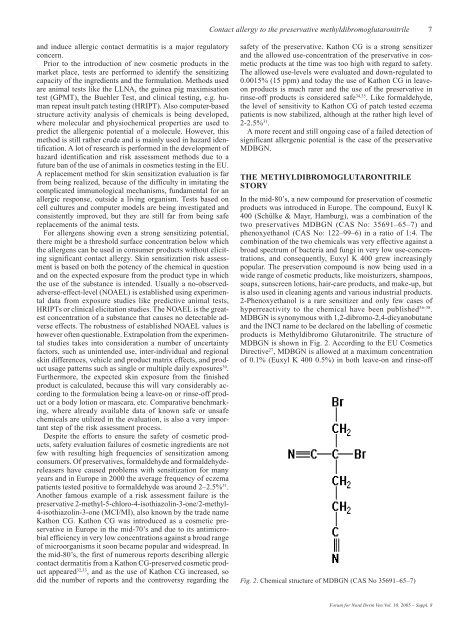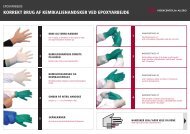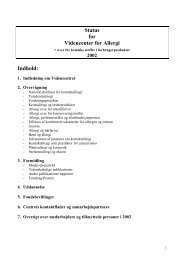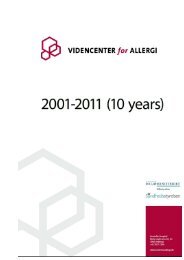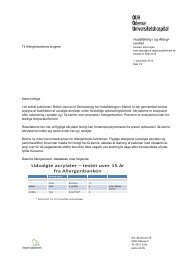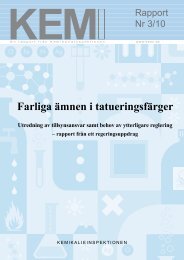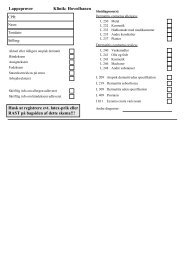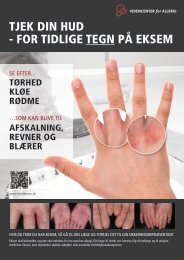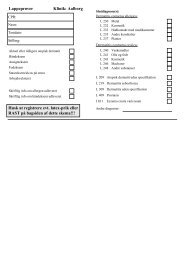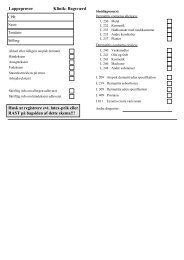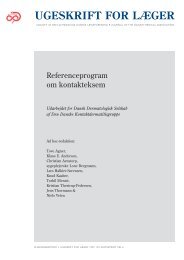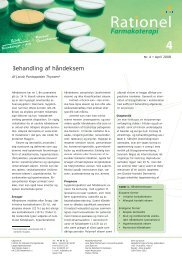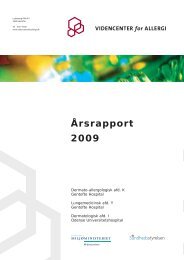Charlotte Devantier Jensen.pmd - Videncenter for Allergi
Charlotte Devantier Jensen.pmd - Videncenter for Allergi
Charlotte Devantier Jensen.pmd - Videncenter for Allergi
You also want an ePaper? Increase the reach of your titles
YUMPU automatically turns print PDFs into web optimized ePapers that Google loves.
and induce allergic contact dermatitis is a major regulatory<br />
concern.<br />
Prior to the introduction of new cosmetic products in the<br />
market place, tests are per<strong>for</strong>med to identify the sensitizing<br />
capacity of the ingredients and the <strong>for</strong>mulation. Methods used<br />
are animal tests like the LLNA, the guinea pig maximisation<br />
test (GPMT), the Buehler Test, and clinical testing, e.g. human<br />
repeat insult patch testing (HRIPT). Also computer-based<br />
structure activity analysis of chemicals is being developed,<br />
where molecular and physiochemical properties are used to<br />
predict the allergenic potential of a molecule. However, this<br />
method is still rather crude and is mainly used in hazard identification.<br />
A lot of research is per<strong>for</strong>med in the development of<br />
hazard identification and risk assessment methods due to a<br />
future ban of the use of animals in cosmetics testing in the EU.<br />
A replacement method <strong>for</strong> skin sensitization evaluation is far<br />
from being realized, because of the difficulty in imitating the<br />
complicated immunological mechanisms, fundamental <strong>for</strong> an<br />
allergic response, outside a living organism. Tests based on<br />
cell cultures and computer models are being investigated and<br />
consistently improved, but they are still far from being safe<br />
replacements of the animal tests.<br />
For allergens showing even a strong sensitizing potential,<br />
there might be a threshold surface concentration below which<br />
the allergens can be used in consumer products without eliciting<br />
significant contact allergy. Skin sensitization risk assessment<br />
is based on both the potency of the chemical in question<br />
and on the expected exposure from the product type in which<br />
the use of the substance is intended. Usually a no-observedadverse-effect-level<br />
(NOAEL) is established using experimental<br />
data from exposure studies like predictive animal tests,<br />
HRIPTs or clinical elicitation studies. The NOAEL is the greatest<br />
concentration of a substance that causes no detectable adverse<br />
effects. The robustness of established NOAEL values is<br />
however often questionable. Extrapolation from the experimental<br />
studies takes into consideration a number of uncertainty<br />
factors, such as unintended use, inter-individual and regional<br />
skin differences, vehicle and product matrix effects, and product<br />
usage patterns such as single or multiple daily exposures 30 .<br />
Furthermore, the expected skin exposure from the finished<br />
product is calculated, because this will vary considerably according<br />
to the <strong>for</strong>mulation being a leave-on or rinse-off product<br />
or a body lotion or mascara, etc. Comparative benchmarking,<br />
where already available data of known safe or unsafe<br />
chemicals are utilized in the evaluation, is also a very important<br />
step of the risk assessment process.<br />
Despite the ef<strong>for</strong>ts to ensure the safety of cosmetic products,<br />
safety evaluation failures of cosmetic ingredients are not<br />
few with resulting high frequencies of sensitization among<br />
consumers. Of preservatives, <strong>for</strong>maldehyde and <strong>for</strong>maldehydereleasers<br />
have caused problems with sensitization <strong>for</strong> many<br />
years and in Europe in 2000 the average frequency of eczema<br />
patients tested positive to <strong>for</strong>maldehyde was around 2–2.5% 31 .<br />
Another famous example of a risk assessment failure is the<br />
preservative 2-methyl-5-chloro-4-isothiazolin-3-one/2-methyl-<br />
4-isothiazolin-3-one (MCI/MI), also known by the trade name<br />
Kathon CG. Kathon CG was introduced as a cosmetic preservative<br />
in Europe in the mid-70’s and due to its antimicrobial<br />
efficiency in very low concentrations against a broad range<br />
of microorganisms it soon became popular and widespread. In<br />
the mid-80’s, the first of numerous reports describing allergic<br />
contact dermatitis from a Kathon CG-preserved cosmetic product<br />
appeared 32,33 , and as the use of Kathon CG increased, so<br />
did the number of reports and the controversy regarding the<br />
Contact allergy to the preservative methyldibromoglutaronitrile 7<br />
safety of the preservative. Kathon CG is a strong sensitizer<br />
and the allowed use-concentration of the preservative in cosmetic<br />
products at the time was too high with regard to safety.<br />
The allowed use-levels were evaluated and down-regulated to<br />
0.0015% (15 ppm) and today the use of Kathon CG in leaveon<br />
products is much rarer and the use of the preservative in<br />
rinse-off products is considered safe 34,35 . Like <strong>for</strong>maldehyde,<br />
the level of sensitivity to Kathon CG of patch tested eczema<br />
patients is now stabilized, although at the rather high level of<br />
2-2.5% 31 .<br />
A more recent and still ongoing case of a failed detection of<br />
significant allergenic potential is the case of the preservative<br />
MDBGN.<br />
THE METHYLDIBROMOGLUTARONITRILE<br />
STORY<br />
In the mid-80’s, a new compound <strong>for</strong> preservation of cosmetic<br />
products was introduced in Europe. The compound, Euxyl K<br />
400 (Schülke & Mayr, Hamburg), was a combination of the<br />
two preservatives MDBGN (CAS No: 35691–65–7) and<br />
phenoxyethanol (CAS No: 122–99–6) in a ratio of 1:4. The<br />
combination of the two chemicals was very effective against a<br />
broad spectrum of bacteria and fungi in very low use-concentrations,<br />
and consequently, Euxyl K 400 grew increasingly<br />
popular. The preservation compound is now being used in a<br />
wide range of cosmetic products, like moisturizers, shampoos,<br />
soaps, sunscreen lotions, hair-care products, and make-up, but<br />
is also used in cleaning agents and various industrial products.<br />
2-Phenoxyethanol is a rare sensitizer and only few cases of<br />
hyperreactivity to the chemical have been published 36-38 .<br />
MDBGN is synonymous with 1,2-dibromo-2,4-dicyanobutane<br />
and the INCI name to be declared on the labelling of cosmetic<br />
products is Methyldibromo Glutaronitrile. The structure of<br />
MDBGN is shown in Fig. 2. According to the EU Cosmetics<br />
Directive 27 , MDBGN is allowed at a maximum concentration<br />
of 0.1% (Euxyl K 400 0.5%) in both leave-on and rinse-off<br />
Fig. 2. Chemical structure of MDBGN (CAS No 35691–65–7)<br />
Forum <strong>for</strong> Nord Derm Ven Vol. 10, 2005 – Suppl. 8


